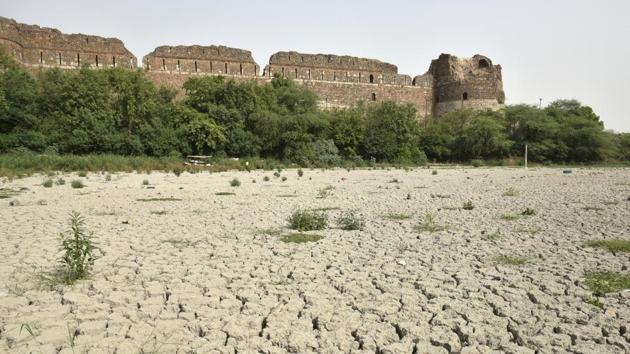Half of Delhi’s 1,000 water bodies vanished due to garbage dumping, encroachments
Delhi relies heavily on the polluted Yamuna, neighbouring Haryana for its water supply. The groundwater table is also fast depleting. Natural and artificial water bodies in the city are being targeted by land sharks as well as local residents who have turned them into garbage dumps.
More than half of Delhi’s 1000 water bodies have either dried up, encroached upon or acquired for infrastructure development. That is bad news for a city which relies heavily on heavily polluted Yamuna and neighbouring states for its water supply and has a fast depleting groundwater table.

Those which still have some semblance of a water body left are being used as sewage and waste dumping spots and are drying up.
The Hindustan Times took stock of the water bodies in Delhi to find out what ails them and how they can be revived.
Pollution kills
Every time a breeze sweeps across Aya Nagar in south Delhi, Sunita Kaul a homemaker has to either cover her nose or has to shut the kitchen window that overlooks a pond that sprawls over nearly an acre.
Locals once used to bathe and drink water from the same pond. But now it chokes with garbage and its black water stinks.
“Most of the drains that carry the locality’s sewage empty directly into the pond. There is an open vat on the banks of the pond and people often dump their garbage in the pond. The stench is horrible at times,” she said.
Experts claimed that the ponds located in the villages and illegal colonies are the most vulnerable. With no proper drainage system in these areas, locals use these water bodies as dumping grounds.
“We have been fighting over the past two years and almost Rs 1.2 crore has been spent. There is a high court order to build a sewage treatment plant. But nothing has happened,” said Ved Pal, a social activist and the newly elected local councillor of Aya Nagar.
Land sharks choke ponds
Barely a kilometre away another pond in Aya Nagar has been choked with aquatic weeds like water hyacinth. Locals dump waste into it and the drains too empty their sewage here.
“Land sharks are trying to encroach upon it. They are dumping waste almost every day to fill it up,” said a local resident who didn’t want to be named.
Official estimates show that around 200 water bodies in the city have been partially or fully encroached upon.
“Most of the encroached water bodies are in the villages which are under the jurisdiction of the BDOs. North Delhi and south west Delhi have the highest number of encroached water bodies,” said a senior environment department official.
Drying up fast
Several of the city’s perennial water bodies have either partially or completely dried up over time. The iconic water body which forms a part of the moat of the Purana Quila has been lying dry over the past eight months.
Apart from the falling water table and the interrupted flow of water channels, experts claimed that the skewed rainfall pattern could also be one of the reasons behind drying up of the water bodies.
“Heavy rains on some days followed by spells of dry weeks are not favourable for recharging the water bodies. Most of the rain water goes down the drain,” said SD Singh chief executive officer of the parks and garden society.
Many dried up water bodies have become playing fields for the locals and grazing grounds for cattle. In some areas parks and roads have been developed on the dried up beds of the water bodies.
“Even though most of the legal acquisitions of the water bodies were done before 2007 to build schools, commercial buildings and offices, illegal encroachment is still going on. The most vulnerable are the village ponds and those in the unauthorised colonies,” said V K Jain of TAPAS, a city-based NGO.
Hope floats
Some water bodies such as the Sanjay Lake in east Delhi are a beacon of hope amid the gloom that surrounds water conservation efforts in Delhi.
It is one of the largest water bodies of Delhi at nearly 70 acres and a part of it – around 20 acres - has already been restored in phase I.
A park has been set up by Delhi Tourism and Transportation Development Corporation (DTTDC) in association with the Delhi Development Authority (DDA) under PPP mode. The DDA created the rainwater lake in the 1970s.
“The park attracts around 500 visitors on an average during the weekends. People mainly come here to enjoy the cool breeze and the fresh air that the water body generates,” said a security guard of the lake.
The National Green Tribunal had recently directed the Delhi government and the corporations to revive and restore all the water bodies across the city. The direction came in the wake of a proposal floated by the Delhi Jal Board (DJB) to revive a water body at Rajokari.
The NGT has, however, made it clear that there should be no use of concrete, cement and brick and should not result in changing the natural geomorphology of the area.
Stay updated with all top Cities including, Bengaluru, Delhi, Mumbai and more across India. Stay informed on the latest happenings in World News along with Delhi Election 2025 and Delhi Election Result 2025 Live, New Delhi Election Result Live, Kalkaji Election Result Live at Hindustan Times.
Stay updated with all top Cities including, Bengaluru, Delhi, Mumbai and more across India. Stay informed on the latest happenings in World News along with Delhi Election 2025 and Delhi Election Result 2025 Live, New Delhi Election Result Live, Kalkaji Election Result Live at Hindustan Times.





